What is strategic workforce planning?
There is a lot of debate as to what strategic workforce planning means. In simple terms, it’s the process wherein an organization considers the skills and abilities of its current workforce and anticipates future requirements. It includes setting up a career pathway to upskilling or reskilling the workforce to close any future skills gaps that may arise due to technological advancements.
The essential steps of strategic workforce planning include:
Supply analysis
The first step is to analyze the external and internal factors affecting the workforce. These include internal factors like the average employee age and external factors like economic trends.
Demand analysis
The next step includes analyzing future job trends, the skills required to efficiently fill job roles, the number of employees needed in the future, and so on. At this step, HR leaders should also prepare skills and talents that will be in demand in the future.
Gap analysis
The third step focuses on identifying skill and talent gaps within the current workforce. Gap analysis allows the execution of strategies smoothly, eliminating risks in the early stage. These risks could be issues of new skills needed for the future, behavioral needs, assessment of internal performance, or retention turnover. Gap analysis helps the organization understand the gaps between the desired future state and the current state.
Solution analysis
The final step lays down a plan for potential solutions in the form of recruitment, upskilling or reskilling, types of training, and so on.
Read the full guide to understand techniques that can be used to perform the above-mentioned analysis.
Key workforce planning objectives
According to an Economist Intelligence Unit survey, companies pursue several key objectives with their strategic workforce planning:
Source: Economist Intelligence Unit Survey, 2016
Creating a positive and inclusive organizational culture
When organizations hire globally, employees come from diverse cultures. Therefore, it’s crucial to create a work culture that is positive, inclusive, and can contribute to improved outcomes for all employees. Strategic workforce planning helps to meet widening recruitment and retention challenges, and in order to do so, HR leaders need the right culture and appropriate support, policies, and processes in place that make people want to work for and stay with the organization.
Developing a sustainable and resilient workforce
HR leaders strive to develop a sustainable, future-proof workforce with the increasing demand for talent. Strategic workforce planning helps you outline priorities and allocate the resources needed to move forward in a sustainable way.
For example, one of the key tasks of workforce planning is to ensure that employees aren’t faced with unrealistic workloads, which significantly contributes to workforce sustainability and resilience.
Keeping the workforce supported, empowered, respected, and engaged
Keeping employees happy and motivated requires HR leaders to help boost their work-life balance and set a clear path for their career growth. Accomplishing this will transform how the organization is seen and how it operates as an employer. Actions related to benchmarking employee engagement and satisfaction are included in strategic workforce planning.
Providing the workforce with the knowledge, skills, and behaviour capable of meeting future demands
For a competent workforce, organizations need to build a breadth of skills, knowledge, and expertise that will help them realize positive outcomes. Strategic workforce planning includes defining the level of skills and expertise required in each role and providing structure and development pathways for employees. These actions further offer support in the recruitment and retention of employees and provide them with opportunities to build successful careers.
How to improve your strategic workforce planning
You can’t achieve the ultimate strategic workforce plan overnight, and to realize your organization’s goal, your plan must be consistently monitored, evaluated, and most importantly improved. If your company has not yet adopted a strategic workforce model, read the basic steps on our blog to get started.
For those companies that have already adopted the strategic workforce planning model, below are some ways to improve it so it can be more adaptable to future needs and changes.
Speed up the planning process
One of the major challenges of strategic workforce planning is the speed with which it takes place. Automating talent management, scenario planning, and other administrative tasks using HR tech solutions can take the burden off HR leaders, allowing them to focus on aligning strategic workforce planning with the changing needs of the business and avoid human errors influencing decision-making.
A centralized HRIS platform leverages data-driven insights across all stages of the strategic workforce planning lifecycle and provides an impetus for businesses to accelerate their digital transformation timelines. For example, using AI-powered systems can help HR leaders find the right talent faster by sourcing and matching talents within the internal market. The process reduces the time to fill roles and further reduces costs from selecting the wrong fit for a role.
Find the areas in your strategic workforce plan that have the most impact on cost-saving
Every organization strives to optimize the use of its crucial resource, i.e., its employees, to cut costs. Our guide helps to assess risks before any misguided cost-cutting actions occur. The guidelines will help you move from a reactionary to a proactive approach so you don’t fall short of your organization’s revenue goals.
Target the right people to involve in decision-making
For most companies, it’s unclear who is ultimately responsible for strategic workforce planning. For some, it is the HR department, while others argue it is the C-level managers. However, with the volatility of the talent market, strategic workforce planning needs to be fluid, and decisions related to changes should be made regularly. This makes it the responsibility of both senior management and HR leaders.
By setting up a steering committee made up of top management, line management, and HR specialists, organizations can identify, retain, grow, and promote high-potential opportunities quickly.
Implement scenario planning
Scenario planning includes planning for both unexpected events like pandemics, economic crises, and war as well as expected future events like an aging workforce, management of remote teams, upskilling according to the changing technological landscape, and changing customer demands.
By running all simulations in the strategic workforce planning process, organizations can prepare for different scenarios that may take place. When undertaken efficiently, scenario planning by analyzing trends can give a competitive advantage to organizations to comprehend the future state of the business and realign their capabilities by following up with strategies needed to implement them.
For example, the pandemic brought a fundamental shift in consumer behavior towards more digital and remote interactions. In response, businesses considered solutions to boost technology adoption, customize marketing campaigns, merge with delivery companies to reach customers quickly, and so on. These require investments in product development, marketing, and IT.
Smart HR software can help organizations investigate the key skills and investments in upskilling and reskilling required for future job roles to step up to new challenges.
Guide to strategic workforce planning
At HRForecast, we know that technological advances, increasing customer expectations, and demographic shifts are just some of the challenges faced by companies when it comes to strategic workforce planning. Our holistic approach to providing strategic workforce planning solutions includes but is not limited to:
- A workforce profile dashboard that provides in-depth statistics and analysis of current employees’ skills and characteristics
- A flexible strategic planning framework designed to pivot companies through an ad hoc state
- The ability to implement changes to employment opportunities with future work trends by matching employees’ skills and learning needs to future roles
- Determining what roles will be created in the future, best practices of recruitment, monitoring, and performance evaluation, and career planning for the workforce
- Driving organizational performance by helping leaders define clear outcomes and objectives and clarifying for employees how their work fits into the bigger picture
Contact us to learn how HRForecast can help your company with strategic workforce planning.
Stay up to date with our newsletter
Every month, we’ll send you a curated newsletter with our updates and the latest industry news.




























 info@hrforecast.de
info@hrforecast.de
 +49 89 215384810
+49 89 215384810






